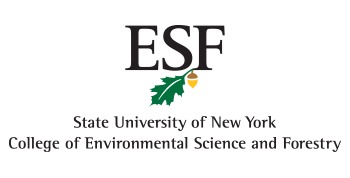
The Adirondack Ecological Center (AEC) is the leader in ecological sciences in the Adirondack Mountains of northern New York and a major contributor to international, place-based research. The mission of the AEC is to understand the Adirondack ecosystem through research and education.
The AEC was established in 1971 by the State University of New York College of Environmental Forestry (ESF) in Syracuse. AEC is located on ESF’s Huntington Wildlife Forest (HWF), a 15,000 acre (6,000 ha) field station in Newcomb, NY in the geographic center of the six-million-acre Adirondack Park. HWF is known as the ESF Newcomb Campus and was established by Anna Hyatt and Archer Huntington in 1932 as an experimental research site. Intensive biological surveys and weather data collection began in the 1930’s under the auspices of the Roosevelt Wild Life Research Station at the New York State College of Forestry at Syracuse, what is now SUNY ESF.
The Newcomb Campus is home to the Adirondack Interpretive Center, a public education facility. Also located on the Newcomb Campus is the Northern Forest Institute for Conservation Education and Leadership Training (NFI) with a focus on education, leadership and stewardship of both natural and designed environments. AEC lies in the middle of the Champlain-Adirondack Biosphere Reserve which is a focus of ESF’s SUNY Center for Bioregional & Biosphere Reserve Studies and links the protected yet lived-in Adirondack landscape to similar UNESCO-designated regions in Canada and the world.
Investigations relating to local to global forest and freshwater management practices are an integral part of the research program at the AEC and a major component of Adirondack Long-Term Ecological Monitoring Program (ALTEMP) activities. Managed stands, together with undisturbed sites, are included in most ALTEMP surveys. Regular measurement of a wide range of parameters collected from over 300 Continuous Forest Inventory (CFI) plots, herbivore exclosure sites, and wildlife habitat survey points periodically document the plant community. Watersheds are intensively monitored for air and water quality, and remote sensors are deployed over space and time. The Adirondack landscape on and around HWF has minimal infrastructure or development and allows researchers and decision-makers to better understand the ramifications of natural resource policy and practices.
-

- North America
- 1 Forestry Drive
- Syracuse
- 13210
- United States
- New York
- 43
- 74
- newcomb@esf.edu
- https://www.esf.edu/aec/
- 1971
- 1990
- Yes
- State University of New York College of Environmental Science and Forestry
- 1 Forestry Drive
- Syracuse
- 13210
- United States
- New York
- Ann-Marie O'Donnell
- newcomb@esf.edu
- Guest Services Manager
- 6312 State Route 28N, Newcomb, NY 12852
- +15185824551
- Stacy McNulty
- smcnulty@esf.edu
- Paul B. Hai
- pbhai@esf.edu
- AEC Business Manager
- AECBusiness@esf.edu
- smcnulty@esf.edu
- $500,001 - $1,000,000
- 5001-10000
- No
- Yes
- UNESCO Biosphere Reserve program; GLEON
- Yes
- Yes
- 11-20
- 6-10
- 50+
- 101+
- Yes
- Yes
- On Grid
- 0-20 minutes
- Yes
- Yes
- Onsite public programs
- Yes
- Yes
- Yes
- Terrestrial
- Boreal Forest
- 301-750 meters
- 751-1500 meters
- C (temperate)
- Yes
- Rural
- Yes
- Yes
- Yes
- Yes
- Yes
- Yes
- Yes
- Yes
- 50
- 15
- 35
- Year Founded
- 1971
- Year Joined OBFS
- 1990
- Size of Field Station (hectares)
- 5001-10000
- FSML Web Address
- https://www.esf.edu/aec/
- Private nonprofit organization?
- No
- Universities affiliated / Parent Organization
- State University of New York College of Environmental Science and Forestry
- Federal, state, or local governmental partners?
-
No
- Member of the Virtual Field
- No

